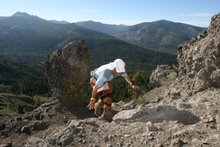
Leona Divide is a masochistic race with 9,000 feet of gain and 9000 feet of loss and virtually no flat sections. From a terrain perspective, 99% of it is quite runable (assuming you can “run” on a narrow, single-track trail, carved from the mountain side, for miles and miles uphill and then do it again while holding your balance going downhill).
With the last 25 miles forming a loop, it allows you to see (or narrowly avoid, as the case may be) the frontrunners seemingly effortlessly zipping down hill, as you are sucking wind trekking uphill to the turnaround (which cruelly enough is a quarter of a mile past the “turnaround” aid station). I tracked the time interval between the top five runners and gave them their lag times as they flew by me. Last year’s winner was in second place when he passed me, only 90 seconds behind the then current leader, and was particularly appreciative of the info. He went on to win again this year in just under 7 hours. It’s sickening to think that I was just at mile 35 when he had already finished!
Other runners told me that the course has phenomenal vistas, but with a bum ankle my eyes were focused on only one thing – the next 10 feet of terrain in front of me. This strategy served me well; aside from popping Advil’s to control the pain and swelling, I suffered no additional ankle sprains during the race.
My wife and son crewed for me well, allowing me to get in and out of the aid stations within 15 seconds and keep my schedule, hitting every aid station within 5 minutes of my predicted time. That is, except for the aid station at mile 42.6 when I arrived 30 seconds too early and there was no crew to be found around. I paid for it dearly during the last 7.4 miles, arriving to the finish line 9 minutes later than my 10-hour predicted finishing time (it feels better to place the blame on someone other than yourself). My wife, of course, blames me for being off by a full 30 seconds after 8 hours and 34.5 minutes of mountain running.
While you might question the purpose of running ultras after the masochistic Leona Divide, it’s definitely a good training race for Western States. I’ll be sure to recommend it to all my friends in need of a little suffering (at least three come to mind).


